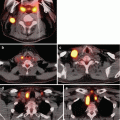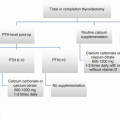1999
2005
Procedure
High
Low
p valuea
High
Low
p valuea
Oncology
Colectomy
Mortality (%)
1.3
3.5
<0.001
2.3
2.8
NS
LOS (mean days)
8.5
10.0
<0.001
8.1
9.7
<0.001
Esophagectomy
Mortality (%)
0.0
6.8
<0.05
0.6
8.8
<0.05
LOS (mean days)
11.2
17.4
<0.001
12.5
18.5
<0.05
Gastrectomy
Mortality (%)
4.0
6.6
NS
3.8
6.8
NS
LOS (mean days)
11.4
14.0
<0.05
13.0
14.8
<0.05
Lung lobectomy
Mortality (%)
2.5
3.9
NS
1.4
3.3
<0.05
LOS (mean days)
7.1
9.1
<0.001
6.4
8.9
<0.001
Pancreatectomy
Mortality (%)
2.5
10.3
<0.05
2.5
9.0
NS
LOS (mean days)
13.3
20.6
<0.001
13.6
24.1
<0.001
Thyroidectomy
Complications (%)
2.5
7.1
<0.001
4.9
7.9
<0.001
LOS (mean days)
1.4
2.4
<0.001
1.3
2.3
<0.001
Cardiovascular
CABG
Mortality (%)
2.4
4.1
<0.001
2.0
2.3
NS
LOS (mean days)
8.9
9.7
<0.001
9.1
9.6
<0.001
CEA
Mortality (%)
0.5
1.0
<0.05
0.2
0.4
NS
LOS (mean days)
2.7
4.5
<0.001
2.3
3.9
<0.001
Table 12.2
Adjusted increased length of stay for low-volume surgeons compared with high-volume surgeons, by year
1999 | 2005 | |||
|---|---|---|---|---|
Procedure | Odds ratio (CI) | p valuea | Odds ratio (CI) | p valuea |
Oncology | ||||
Colectomy | 2.3 (1.5–3.6) | <0.001 | 1.0 (0.7–1.3) | NS |
Gastrectomy | 1.2 (0.4–4.1) | NS | 1.3 (0.5–3.2) | NS |
Lung lobectomy | 1.2 (0.6–2.5) | NS | 1.3 (0.5–3.2) | NS |
Thyroidectomy | 1.8 (0.9–3.6) | NS | 1.4 (0.9–2.2) | NS |
Cardiovascular | ||||
CABG | 1.4 (1.1–1.8) | <0.05 | 0.9 (0.6–1.3) | NS |
CEA | 1.2 (0.5–3.2) | NS | 2.3 (0.6–8.1) | NS |
Surgical specialization also appears to be related to improved patient outcomes. A systematic review analyzed studies on hospital volume, surgeon volume, and surgeon subspecialty. This review identified 58 studies related to surgical volume and found 74 % of studies reported better outcomes with high-volume surgeons. Surgical subspecialization was specifically evaluated in 22 studies. The majority of these studies evaluated specialization in surgical oncology and vascular surgery, and two studies looked exclusively at endocrine surgery. The entire cohort included 144,421 patients. Surgical subspecialists had significantly better outcomes than general surgeons performing the same procedure in 20 of 22 studies (91 %). Lower mortality rates were seen in 11 of 12 studies (92 %), and lower complications rates were observed in 14 of 17 studies (82 %). In studies that evaluated surgical subspecialization and length of stay, specialists had shorter hospital length of stay in all studies [6].
Surgeon Volume and Thyroidectomy
Sosa et al. published the earliest study addressing surgeon experience and its relationship to short-term clinical and economic outcomes specifically for thyroidectomy [8]. The authors reviewed 5,860 patients that underwent thyroidectomy for both benign and malignant disease between 1991 and 1996 in a single state. Surgeons were stratified into four groups by case volume over the 6-year period (1–9 cases, 10–29 cases, 30–100 cases, and >100 cases). Nearly two thirds of surgeons performed, on average, less than one thyroidectomy per year. The highest-volume surgeons represented less than 1 % of surgeons but performed 14 % of the cases. Thyroidectomies performed by high-volume surgeons were more complex (29 % total thyroidectomy vs. 15 % in the lowest-volume group) and the highest-volume surgeons more likely to operate on patients with thyroid cancer, compared to the lowest-volume surgeons (31 % vs. 23 %). The highest-volume surgeons also had significantly fewer complications, including both thyroidectomy-specific complications such as recurrent laryngeal nerve injury and hypoparathyroidism as well as those indirectly related to surgery such as drug reactions (p < 0.001). Regarding length of stay, the highest-volume surgeon had the shortest length of stay 2.8 days vs. 1.7 days and 1.9 days vs. 1.4 days (p < 0.05), before and after adjustment for differences in patient characteristics, procedure, hospital volume, and time period. When analyzed by indication for surgery, differences between surgeon volume and outcomes persisted for the 1,470 patients with thyroid cancer. The complication rate in patients with thyroid cancer was overall higher than in those with adenomas 8.1 % vs. 4.8 % (p < 0.001). Complications occurred in 4.7 % of the patients operated on by the highest-volume surgeon versus 12.9 % in the lowest group (p < 0.001). The length of stay was 1.4 days versus 2.1 days (p < 0.001) (Table 12.3) [8].
Table 12.3
Adjusted outcomes of surgeon volume groups by diagnosis (Reprinted with permission from Ref. [8])
Outcome, by | Diagnosis | ||
|---|---|---|---|
Surgeon volume | Adenoma | Other benign | Cancer |
Group (case/year) | (n = 1381) | (n = 3009) | (n = 1470) |
Complications | (%) | (%) | (%) |
A (1–9 cases) | 5.7NS | 9.1a | 12.9c |
B (10–29 cases) | 5.0 NS | 6.2a | 8.0 NS |
C (30–100 cases) | 4.2 NS | 6.2a | 9.4a |
D (>100 cases) | 7.6 ref | 6.0 ref | 4.7ref |
Length of stay | (Days) | (Days) | (Days) |
A (1–9 cases) | 1.7c | 2.0c | 2.1c |
B (10–29 cases)
Stay updated, free articles. Join our Telegram channel
Full access? Get Clinical Tree
 Get Clinical Tree app for offline access
Get Clinical Tree app for offline access

|



